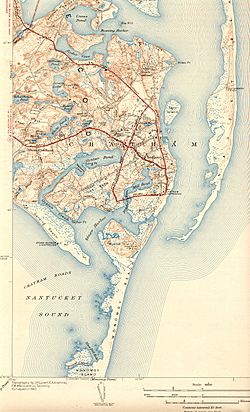Oyster Pond River facts for kids
The Oyster Pond River, also called Oyster Creek, is a short river in Chatham, Massachusetts, on Cape Cod. It's about 1.7 miles (2.7 km) long.
This river is an estuary, which means it's where fresh water from the land mixes with salty ocean water. The Oyster Pond River connects a place called Oyster Pond with Stage Harbor. It's usually about 3 to 5 feet (0.9 to 1.5 meters) deep. Along its sides, you'll find salt marshes, which are wetlands filled with special plants that can grow in salty water. Both the river and Oyster Pond are great places for boats to anchor safely. The total surface area of the river is about 88.1 acres (35.7 hectares).
Contents
Exploring Oyster Pond
Oyster Pond is a special part of the river system.
History Around Oyster Pond
Back in 1896, the Chatham Railroad Depot was built. Chatham was the very last town on Cape Cod to get a railroad! This new train service brought a lot of tourists to Chatham. Many fancy summer homes were built near Oyster Pond because it was such a beautiful spot. One of these homes, the Louis Brandeis House, is now a very important historical site called a National Historic Landmark.
Studying Oyster Pond
A scientist named Kenneth O. Emery (1914–1998) from the Woods Hole Oceanographic Institution wrote a famous book about Oyster Pond. It was called A Coastal Pond Studied by Oceanographic Methods and came out in 1969. This book gave a lot of details about the pond, including its shape, how it was formed, its water, and the living things in it.
The pond used to have many oysters, but they all disappeared in the late 1800s. This happened because the pond's connection to Stage Harbor was filled in to build the railroad. In the late 1960s, Oyster Pond was about 25 hectares (62 acres) in size. Its average depth was 3 meters (10 feet), and the water had about 1.7 grams of salt per kilogram of water. Many studies have been done on the pond over the years.
Protecting Oyster Pond
To help protect Oyster Pond and its natural environment, a group called the Oyster Pond Environmental Trust (OPET) was created.
In 1996, OPET reissued A Coastal Pond Studied by Oceanographic Methods. This new version included an update by Dr. Brian Howes and Dr. Stanley Hart. They wrote about how the pond had changed from the 1960s to the mid-1990s. The update also described a plan started in the mid-1990s to keep the saltiness of the pond's water (called salinity) between 2 and 4 ppt (parts per thousand).
More than 200 different kinds of birds use the marshes, forests, thickets, and open water around Oyster Pond. They come here to breed, to stop during their long migrations, and to spend the winter.


